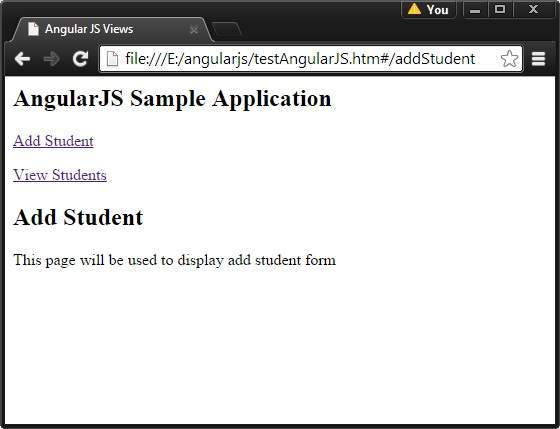AngularJS supports Single Page Application via multiple views on a single page. To do this, AngularJS has provided ng-view and ng-template directives, and $routeProvider services.
ng-view Directive
The ng-view directive simply creates a place holder where a corresponding view (HTML or ng-template view) can be placed based on the configuration.
Usage
Define a div with ng-view within the main module.
<div ng-app="mainApp"> ... <div ng-view></div> </div>
ng-template Directive
The ng-template directive is used to create an HTML view using script tag. It contains id attribute which is used by $routeProvider to map a view with a controller.
Usage
Define a script block with type as ng-template within the main module.
<div ng-app="mainApp">
...
<script type="text/ng-template" id="addStudent.htm">
<h2> Add Student </h2>
{{message}}
</script>
</div>
$routeProvider Service
The $routeProvider is a key service which sets the configuration of URLs, maps them with the corresponding HTML page or ng-template, and attaches a controller with the same.
Usage 1
Define a script block with type as ng-template within the main module.
<div ng-app="mainApp">
...
<script type="text/ng-template" id="addStudent.htm">
<h2> Add Student </h2>
{{message}}
</script>
</div>
Usage 2
Define a script block with main module and set the routing configuration.
var mainApp = angular.module("mainApp", ['ngRoute']);
mainApp.config(['$routeProvider',
function($routeProvider) {
$routeProvider.
when('/addStudent', {
templateUrl: 'addStudent.htm',
controller: 'AddStudentController'
}).
when('/viewStudents', {
templateUrl: 'viewStudents.htm',
controller: 'ViewStudentsController'
}).
otherwise({
redirectTo: '/addStudent'
});
}]);
The following points are important to be considered in the above example:
- $routeProvider is defined as a function under config of mainApp module using key as '$routeProvider'.
- $routeProvider.when defines a URL "/addStudent", which is mapped to "addStudent.htm". addStudent.htm should be present in the same path as main HTML page. If the HTML page is not defined, then ng-template needs to be used with id="addStudent.htm". We used ng-template.
- "otherwise" is used to set the default view.
- "controller" is used to set the corresponding controller for the view.
Example
The following example shows the use of all the above-mentioned directives.
testAngularJS.htm
<html>
<head>
<title>Angular JS Views</title>
<script src="http://ajax.googleapis.com/ajax/libs/angularjs/1.2.15/angular.min.js"></script>
<script src="http://ajax.googleapis.com/ajax/libs/angularjs/1.2.25/angular-route.min.js"></script>
</head>
<body>
<h2>AngularJS Sample Application</h2>
<div ng-app="mainApp">
<p><a href="#addStudent">Add Student</a></p>
<p><a href="#viewStudents">View Students</a></p>
<div ng-view></div>
<script type="text/ng-template" id="addStudent.htm">
<h2> Add Student </h2>
{{message}}
</script>
<script type="text/ng-template" id="viewStudents.htm">
<h2> View Students </h2>
{{message}}
</script>
</div>
<script>
var mainApp = angular.module("mainApp", ['ngRoute']);
mainApp.config(['$routeProvider',
function($routeProvider) {
$routeProvider.
when('/addStudent', {
templateUrl: 'addStudent.htm',
controller: 'AddStudentController'
}).
when('/viewStudents', {
templateUrl: 'viewStudents.htm',
controller: 'ViewStudentsController'
}).
otherwise({
redirectTo: '/addStudent'
});
}]);
mainApp.controller('AddStudentController', function($scope) {
$scope.message = "This page will be used to display add student form";
});
mainApp.controller('ViewStudentsController', function($scope) {
$scope.message = "This page will be used to display all the students";
});
</script>
</body>
</html>
Output
Open the file testAngularJS.htm in a web browser and see the result.



No comments:
Post a Comment